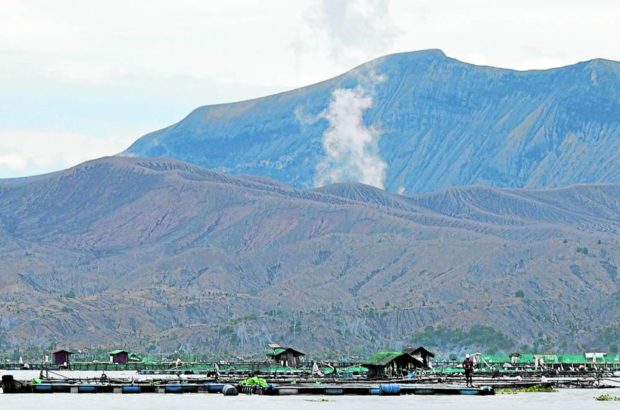
FILE PHOTO: Communities around Taal Volcano in Batangas province have been warned to stay alert amid continuing signs of volcanic unrest. In this photo taken from the Talisay-Tanauan Road on Monday, August 8, 2022, fish cage caretakers in Taal Lake go about their chores unmindful of smoke billowing out of the volcano. INQUIRER/GRIG C. MONTEGRANDE
LUCENA CITY — The Philippine Institute of Volcanology and Seismology (Phivolcs) on Friday afternoon recorded 19 phreatomagmatic explosions at the Taal Volcano.
In its 2 p.m. bulletin, Phivolcs said the “very weak” bursts were detected by remote camera monitoring of the Taal Main Crater between 8:50 a.m. and 1:30 p.m., all emanating from a vent on its northeastern side.
“Some of these events produced 200-meter-tall steam-rich plumes, with a few emanating from very short dark ash plumes that immediately collapsed into the Main Crater Lake,” the report said.
Sulfur dioxide emissions reached an average of around 6,702 tons on Thursday, Phivolcs said.
The agency reminded the public that Alert Level 1 still prevails over Taal Volcano, “which means that it is still in abnormal condition and should not be interpreted to have ceased unrest nor ceased the threat of eruptive activity.”
“Should current phreatomagmatic activity worsen or pronounced changes in monitored parameters forewarn of increasing unrest, the Alert Level may be raised to Alert Level 2,” it added.
READ: Taal still showing signs of unrest
Authorities have barred entry into Taal volcano island, especially within the vicinity of the Main Crater and the Daang Kastila fissure.
Aircraft are also prohibited from flying close to the volcano.
Alert Level 3 was raised over Taal Volcano on March 26 after registering a series of phreatomagmatic bursts.
Phivolcs lowered the volcano status to Alert Level 2 on April 9 following an “overall decreasing trend in the level of monitoring parameters.”
On July 11, the status was further lowered to Alert Level 1. INQ